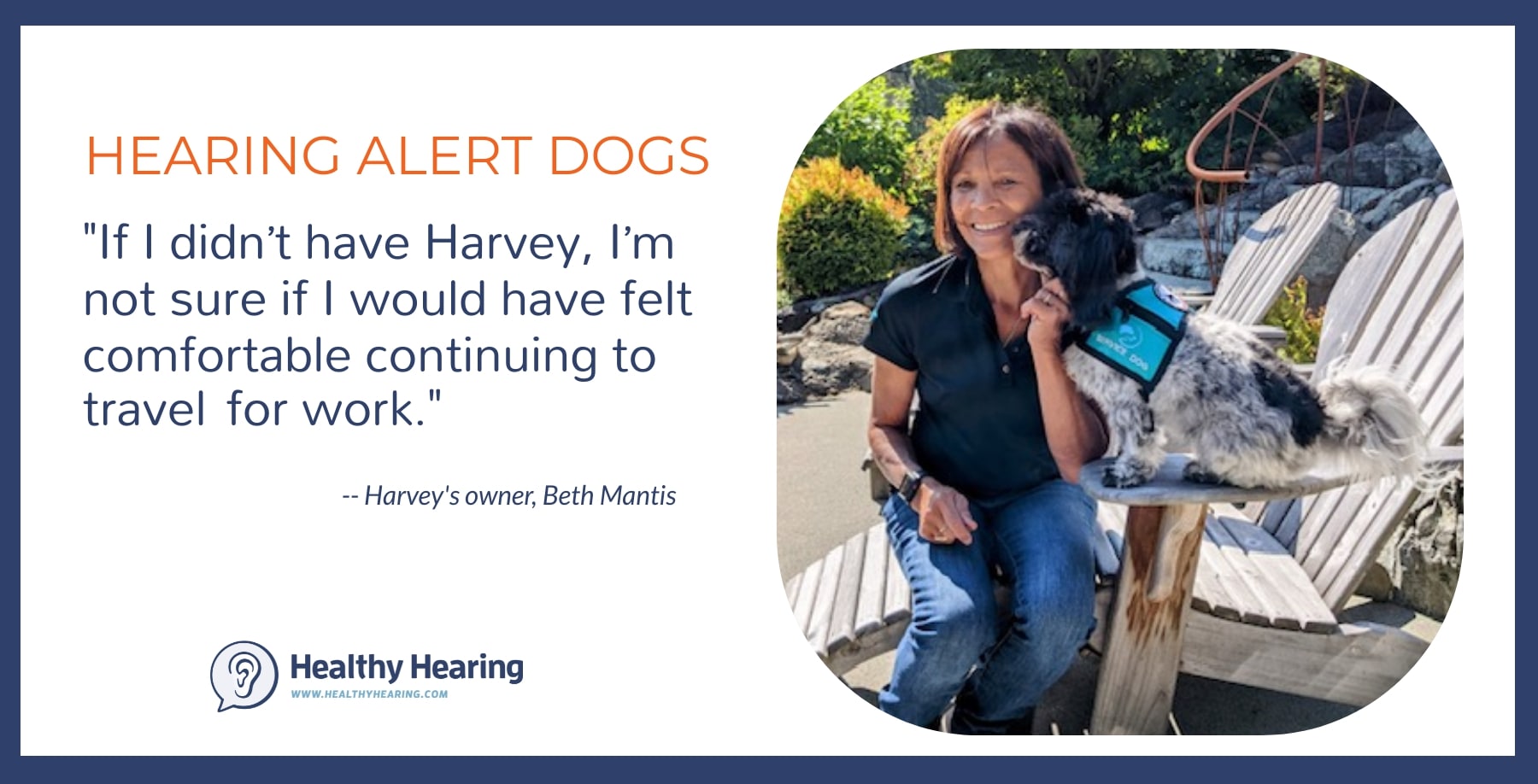|
www.HealthyHearing.com |
Hearing service dogs help alert owners to sounds and situationsPeople can train their own pups or register with a non-profit that provides hearing assistance dogs
Contributed by Linda Childers As Beth Mantis walks into the airport, her hearing alert dog, Harvey, nudges her leg with his nose to let her know someone is approaching from the side. A five-year-old Havanese, Harvey knows that when Mantis gives him the command, “watch,” that he’s helping her to stay safe and aware of her surroundings. Mantis, who has hearing loss in her right ear, and tinnitus that sometimes affects the clarity in her left ear, worked with the non-profit, Atlas Assistance Dogs, to train and certify Harvey to be her hearing alert dog. “I travel a lot for my job as an equine and canine bodywork therapist and I found it challenging to be alone in an unfamiliar place and to not be able to hear when a stranger approaches,” Mantis says.
Her doctor recommended getting a hearing service dog that could assist Mantis with everyday tasks, while also giving her a sense of security. While she liked the idea, Mantis discovered that many organizations only trained larger breeds such as Labrador retrievers. Since she traveled frequently, Mantis wanted a smaller dog that could accompany her on business trips. Trained her own pup to be a hearing alert dogAfter hearing about Atlas Assistance Dogs, Mantis thought the non-profit would be a good fit and she liked their concept of working with dog owners to train their own pups to be service dogs. “It’s important that dogs who begin our service training don’t have temperament, anxiety, fear, or aggression issues,” says Molly Neher, director of operations and programs for Atlas. “All dogs must be at least 14 months old, be socialized, and have passed obedience training.” At Atlas, volunteer dog trainers work with clients such as Mantis and their dogs on a one-to-one basis. Neher says training typically takes place twice a week, over the course of six months, with the program costing $700.
Can alert owners to doorbells, smoke alarms, phones and more“We know there are many people with disabilities who would benefit from having a service dog but face significant obstacles trying to obtain one,” Neher says. “We believe anyone who would benefit from a qualified assistance dog should have one.” Although Atlas is based in Bellevue, Wash., Neher says the non-profit works with clients and dog trainers across the country. “We train hearing alert dogs to notify their owners with either a paw or nose nudge, to sounds including doorbells, smoke alarms, sirens, telephones, and baby monitors,” Neher says. “They can also alert their owner when someone is calling their name or approaching them.” More: Alerting devices for hearing loss 'Harvey has increased my confidence'Through positive reinforcement, hearing alert dogs are taught to recognize specific sounds in their owner’s environment. Dog owners choose three or more tasks they would like their hearing alert dog to learn. For Mantis, that meant having Harvey alert her to whenever someone approaches, helping her to locate her phone, and notifying her when someone is at the door. “In addition to helping me with sounds, Harvey has increased my confidence,” Mantis says. “If I didn’t have Harvey, I’m not sure if I would have felt comfortable continuing to travel for work.” Another common option: Professionally trained hearing alert dogsFor those who would rather be paired with a professionally-trained hearing alert dog, Dogs for Better Lives (formerly known as Dogs for the Deaf) with campuses in Central Point, Oregon, and Falmouth, Massachusetts, can help. The national non-profit places hearing alert dogs with applicants who have moderate to severe hearing loss. Sara Ifert, the organization’s director of marketing, says prospective clients go through an extensive application process that includes an in-home interview and doctor recommendation. “If approved, applicants are placed on our wait list,” Ifert says. “Although it can take up to 36 months, the exact timeframe varies and is based on the needs of the applicant and the dogs we have available for placement.” The Dogs for Better Lives matching process takes under consideration a variety of factors including the needs of the clients for sound work both at home and in public, their lifestyle and energy level, and level of confidence the dog has in new environments and situations. “When a match has been made and the dog is ready for placement with an approved applicant, the dog and trainer travel to the client’s home for a week-long introduction and training period,” Ifert says. “This format has proven highly effective in laying a strong foundation for lifelong support. Both the training and placement process are provided at zero cost to the client.” Hearing alert dogs can accompany owner to work or other settingsDogs for Better Lives uses both shelter dogs and purpose-bred dogs for their Hearing Dog program. “When choosing which shelter dogs to bring into training, we look for the temperament and specific characteristics that we’ve found lead to success in our programs, like confidence, friendliness, focus, and drive,” Ifert says. Dogs are trained using positive reinforcement over the course of four to six months where they learn obedience, socialization, and specialized training. “Many of our hearing alert dogs are also trained and certified for public access so they can accompany their handler to work and alert them to specific on-the-job noises such as a ringing phone or someone calling their name,” Ifert says.
Related Help Pages:
Hearing loss Hearing aids Types of hearing aids Technology Accessories Assistive listening devices and systems Amplified phones Captioned phones and caption apps Hearing aid compatible phones TV hearing aid and listening devices FM/DM systems Alerting devices Tinnitus (ringing in the ears)
|
Featured clinics near me
Earzlink Hearing Care - Reynoldsburg
7668 Slate Ridge Blvd
Reynoldsburg, OH 43068

Find a clinic
We have more hearing clinic reviews than any other site!


